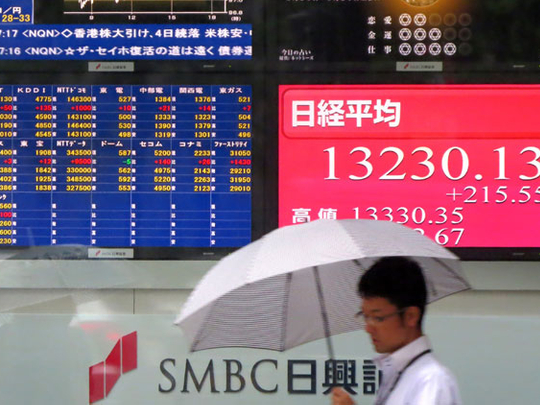
Tokyo: Asian stocks hit a 9-1/2-month low on Friday and faced their worst week since May last year as investors continued to grapple with the US Federal Reserve’s plan to scale back stimulus, while credit markets showed signs of stabilising.
As Asian shares and other assets came off their lows following Thursday’s sharp sell-off, European stocks were seen inching higher, with financial spreadbetters predicting London’s FTSE 100, Paris’s CAC-40 and Frankfurt’s DAX would open up as much as 0.3 per cent.
A 0.5 per cent rise in US stock futures also hinted at a rebound on Wall Street.
China’s stressed money market had a respite from Thursday’s acute credit squeeze, with speculation that the People’s Bank of China had discreetly injected desperately-needed funds, though rates remained elevated.
MSCI’s broadest index of Asia-Pacific shares outside Japan
0.8 per cent, after dipping 1.4 per cent/searlier to its lowest since September, and was set for a weekly loss of 4.3 per cent, its worst weekly drop since May 2012.
Japan’s benchmark Nikkei stock average outshone the rest of the region, reversing an earlier decline of more than 2 per cent to end up 1.7 per cent, with a weaker yen against the dollar improving market sentiment.
Australian shares trimmed earlier losses to fall 0.4 per cent while South Korean shares recovered some ground after skidding 2.4 per cent to their lowest in 11 months. Hong Kong and Shanghai also clawed back some early losses.
“Clearly, the Fed tapering is on the table now...and it will take some time for investors to digest,” said Adrian Foster, head of financial markets research for Asia-Pacific at Rabobank International in Hong Kong.
He added, however, that over the longer term financial markets will regain stability, particularly the US bond market, as the US budget deficit is reined in.
“There are massive buying opportunities coming out of this,” he said.
EMERGING MARKETS UNDER FIRE
Traders said the Bank of Korea intervened in currency markets to slow the won’s slide.
After the intervention, the won traded around 1,151.9 (Dh3.66) per dollar, far above a session low of 1,159.4, but still sharply weaker than Thursday’s domestic close of 1,145.7.
Emerging market assets are seen particularly vulnerable to the changing emphasis of the Fed’s stimulus plan as money starts to find its way to rising US yields and as a firming dollar begins to weigh on dollar-denominated commodities and commodity-linked currencies.
“The combination of rising asset volatility and a steepening US yield curve will likely weigh on currencies reliant on capital imports,” Morgan Stanley said in a research note.
“Commodity and emerging markets countries with current account deficits and large foreign funding liabilities should see significant pressure, as global rebalancing slows demand for raw materials.”
The Indian rupee was at 59.3700 (Dh3.68) on Friday, after slumping to a record low of 59.9850 on Thursday as the Fed’s signalling of a looming end to cheap money raised fears that the country would lose a major channel to fund its record high current account deficit.
The Australian dollar, often seen as a gauge for risk appetite, also recovered to trade at $0.9235 (Dh3.12), after taking a harsh beating overnight to touch its lowest in nearly three years of $0.9163. The resource-reliant Aussie was also weighed by Thursday’s weak Chinese manufacturing activity data.
CURRENCIES
The dollar rose 0.5 per cent against the yen at 97.75 (Dh3.67), moving away from its 10-week low of 93.75 yen hit last week.
Against a basket of key currencies, the dollar was down 0.2 per cent.
US Treasuries stabilised in Asia, with the benchmark 10-year yield little changed from late New York levels of 2.42 per cent, after hitting the highest since August 2011 at 2.471 per cent on Thursday.
A sharp sell-off lured bargain hunters to gold and oil.
Spot gold surged 1.5 per cent to $1,297.59 an ounce as lower prices attracted Chinese buyers, after touching its lowest since September 2010 of $1,268.89 earlier.
Still, it was set for its worst week in nearly two years after tumbling more than 5 per cent overnight in one of its biggest routs since the 2008 financial crisis.
US crude futures reversed earlier losses to rise 0.4 per cent to $95.52 a barrel while Brent climbed 0.6 per cent to $102.72.
Asian credit markets stabilised, with the spread on the iTraxx Asia ex-Japan investment-grade index/swidening just three basis points, after spiking 23 basis points on Thursday, reflecting the rising cost of hedging against debt defaults.
“Investors are patiently doing their homework, biding their time to take stock of the situation,” a credit trader said.












